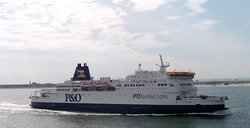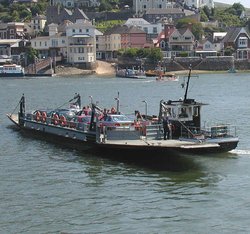Ferry
|
|
A ferry is a boat or a ship carrying passengers, and sometimes their vehicles, on short-distance, scheduled services.
Ferries form a part of the public transport systems of many waterside cities, allowing direct transit between points at a capital cost much lower than bridges or tunnels.
A foot-passenger ferry with many stops, such as in Venice, is sometimes called a waterbus or water taxi.
| Contents |
Notable ferry services
Hkstarferry.JPG
Longer-run ferries connect coastal islands with the mainland. A route of this type connects Great Britain with the rest of Europe across the English Channel, connecting mainly to French ports, such as Calais, Cherbourg and Le Havre. Large ferries also sail in the Baltic Sea between Finland and Sweden. In many ways, these ferries are like cruise ships, but they can also carry hundreds of cars on car decks. In Britain, car-carrying ferries are sometimes referred to as RORO - "roll-on, roll-off" - for the ease by which vehicles can board and leave.
In Australia, three Spirit of Tasmania ferries carry passengers and vehicles 300 km across the Bass Strait, which separates Tasmania from the Australian mainland. These run overnight but also include additional day crossings in peak time. All three ferries are based in the northern Tasmanian port city of Devonport; two ferries travel the route to Melbourne, Victoria, and the third to Sydney, New South Wales.
Hong Kong has the Star Ferry and the First Ferry.
Due to the numbers of large freshwater lakes and length of shoreline in Canada, many provinces and territories have ferry services. British Columbia, has BC Ferries that carries daily commuters from Vancouver Island to the B.C. mainland. In Ontario, a popular ferry service that transports the public, as well as goods and services, is the Chi-Cheemaun. Toronto also has a ferry service that shuttles beach-goers, tourists and aircraft passengers between the downtown core and Toronto Island beach and airport. Until 1997, the only access to the province of Prince Edward Island was by one of two ferry routes, or by air.
Types of ferries
Ferry designs depend on the length of the route, the passenger or vehicle capacity required, speed requirements and the water conditions the craft must deal with. Hydrofoils have the advantage of higher cruising speeds, succeeding hovercraft on the some English Channel routes, where the ferries now compete against the Eurotunnel and Eurostar trains that use the Channel Tunnel. Hydrofoils also proved a practical, fast and relatively economical solution in the Canary Islands - their replacement by high-speed car ferries is seen by critics as a retrograde step given that the new vessels use much more fuel and foster the inappropriate use of cars 1 (http://www.atan.org/en/costas/fast/milenium.htm) in islands already suffering from the impact of mass tourism.
Very short distances may be operated by a cable ferry, where the ferry is propelled and steered by cables connected to each shore. Sometimes the cable ferry is human powered by someone on the boat. Reaction ferries are cable ferries that use the perpendicular force of the current as a source of power. Chain ferries may be used in fast-flowing rivers across short distances.
Free ferries operate in some parts of the world, such as at Woolwich in London, England (across the River Thames), in Amsterdam, Netherlands (across the IJ waterway), and in New York Harbor, connecting Manhattan to Staten Island.
Ferry boats often dock at specialized facilities designed to position the boat for loading and unloading, called a ferry slip. If the ferry transports road vehicles or railcars there will usually be an adjustable ramp called an apron that is part of the slip. In other cases, the apron ramp will be a part of the ferry itself, acting as a wave guard when elevated and lowered to meet a fixed ramp at the terminus - a road segment that extends partially underwater.
First, shortest, largest
On 11 October 1811 inventor John Stevens' ship the Juliana, began operation as the first steam-powered ferry (service was between New York, New York, and Hoboken, New Jersey).
Reputedly, the world's shortest regular ferry route runs 121 m across a shipping channel, connecting Toronto City Centre Airport to the mainland. The ferry between Bygdøy and Lille Herbern in Oslo is significantly shorter, but operates only between April and October.
Ferry.bristol.arp.jpg
The oldest ferry service in continuous operation may be the Sundbåt ("Sound/Strait Boat") shuttle in Kristiansund. Started in 1876, the small motor ferry crosses the harbour from Kirklandet to Innlandet, then Nordlandet, Gomalandet, and back to Kirklandet, repeating the round trip in half-hour intervals morning to evening on weekdays.
Two of the world's largest ferry systems are located in the Strait of Georgia, British Columbia, Canada, and Puget Sound, Washington, United States of America. Each system contains at least 25 ferries, but the two have different styles and operating procedures.
The Sydney Ferries Corporation operates 31 passenger ferries around locations on Port Jackson (Sydney Harbour). It operates catamarans, hydrofoils and other types on these routes, with the most famous likely being the Circular Quay-Manly route.
Metrolink Queensland operates 21 passenger ferries on behalf of Brisbane City Council, 12 being single-hulled ferries and 9 CityCats (catamarans), along the Brisbane River, from the University of Queensland through the city to Brett's Wharf.
Ferries in Antiquity
Ferry_dongan_hills_1945.jpg
Crossing a river as a metaphor for transition is very old. The profession of the ferryman is embodied in Greek mythology as Charon.
Speculation that a pair of oxen propelled a ship having a water wheel can be found in 4th century Roman literature “Anonymus De Rebus Bellicis”. Though impractical, there is no reason why it could not work and such a ferry, modified by using horses, was used in Lake Champlain in 19th century America. See, “When Horses Walked on Water: Horse-Powered Ferries in Nineteenth-Century America" (Smithsonian Institution Press;Kevin Crisman, co-authored with Arthur Cohn, Executive Director of the Lake Champlain Maritime Museum).
See also
- Cable ferry
- RORO, "Roll On/Roll Off" a ferry that carries wheeled cargo
- Train ferry
- Water taxi
List of ferry operators
- Alaska Marine Highway System (northwest US to Alaska)
- Bay Ferries (eastern Canada)
- BC Ferries (western Canada)
- Lake Champlain Transportation Company (on Lake Champlain in the United States)
- Marine Atlantic (eastern Canada)
- Northumberland Ferries (eastern Canada)
- Silja Line (the Baltic Sea)
- SSTH Ocean Arrow
- Stena Line (the United Kingdom, the Baltic Sea)
- Toronto Island Ferry Services
- Viking Line (the Baltic Sea)
- Washington State Ferries (northwest US)
External links
- Greek ferries (http://www.greekferries.gr)
- Alaska Marine Highway System (http://www.dot.state.ak.us/amhs/index.html)
- Interislander: New Zealand's Ferries (http://www.interislander.co.nz/)
- Washington State Ferry website (http://wsdot.wa.gov/ferries)da:Færge
de:Fähre eo:Pramo fr:Ferry (bateau) fy:Fear id:Kapal Feri it:Traghetto ms:Feri nl:Veerpont ja:フェリー pl:Prom sl:Trajekt sv:Färja


